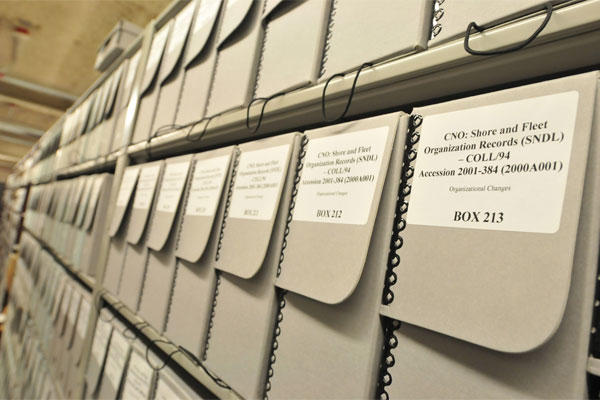RICHMOND, Va. -- The Navy officially stood up its artifact Collection Management Facility (CMF) here May 20 in a small ceremony to thank those involved in making the facility a reality.
"This is not just some collection of old stuff. Every artifact here tells an amazing story about people, the Sailors of the United States Navy whose courage and dedication have served our nation so well for over 200 years, often at great cost. This fine facility helps the Navy keep our promise to our Sailors and their families that we will never forget their sacrifice," said director of the Naval History and Heritage Command (NHHC) Sam Cox.
Naval artifacts had been previously housed in separate facilities in Washington D.C., Springfield, Va., Cheatham Annex, Va. and Memphis, Tenn. The refurbished building in Richmond provides improved environmental controls for high-risk artifacts, proper shelving and storage, and an area for conserving and preserving the artifacts. NHHC currently holds more than 300,000 artifacts in its collection dating back to the founding of the Republic.
"The consolidation of the collection at Richmond is a great first step in improving the environmental conditions in which we store our historical artifacts. The magnitude and pace of the move were unprecedented for us, and I am very grateful to all the NHHC, Navy and DLA professionals who did such an amazing job." said Dr. Jay Thomas, NHHC's assistant director for Collection Management.
The vastly improved arrangement and single facility was chiefly the result of the hard work of the NHHC staff, and a Defense Logistics Agency (DLA) eager to make more efficient and effective use of available storage space.
"We're glad to help safeguard these invaluable possessions by finding a single facility. It removes the inherent inefficiencies of having them scattered in various locations - and the best part is with the necessary storage modifications it'll mean significant improvements for the artifacts," said then-Vice Adm. Mark Harnitchek, who at the time was director of the Defense Logistics Agency. Harnitchek has since retired, and attended the ceremony.
The consolidation now allows the Navy to centrally locate all of the artifacts, which will translate to improved care, management, accountability and oversight of the collection. The building in Richmond will ensure improved environmental controls for high risk artifacts, proper shelving and storage, an area for conserving and preserving the artifacts.
The consolidation, which included a partial refurbishment of the Richmond facility to adequately meet storage condition standards, has positioned the Navy to proceed more efficiently with its end-to-end artifact inventory. The last known complete inventory on record was in 1908.
In the near term, the Navy's Curator Branch will continue to service existing artifact loans, currently numbering in excess of 1,500. Once operations settle in the new facility, curators will again begin processing requests for new artifact loans. They will also soon begin again considering new donations.
The CMF resides on a controlled military installation with access restricted to those who work there. The facility is not suitable for public visitation as the artifacts in the collection are not displayed, but rather packed in containers designed to preserve and protect them. Moreover, the CMF is an industrial area with heavy machinery in use in the main storage areas while delicate, highly-specialized conservation and preservation work takes place in the curatorial spaces. Most importantly, like those of all historical and museum systems with large artifact collections, NHHC's CMF is intended to protect the security of the priceless collection of artifacts dating back to the founding of the republic.
The Naval History and Heritage Command, located at the Washington Navy Yard, is responsible for the preservation, analysis, and dissemination of U.S. naval history and heritage. It provides the knowledge foundation for the Navy by maintaining historically relevant resources and products that reflect the Navy's unique and enduring contributions through our nation's history, and supports the Fleet by assisting with and delivering professional research, analysis, and interpretive services.
NHHC is composed of many activities including the Navy Department Library, the Navy Operational Archives, the Navy art and artifact collections, underwater archeology, Navy histories, nine museums, USS Constitution repair facility and the historic ship Nautilus.


























